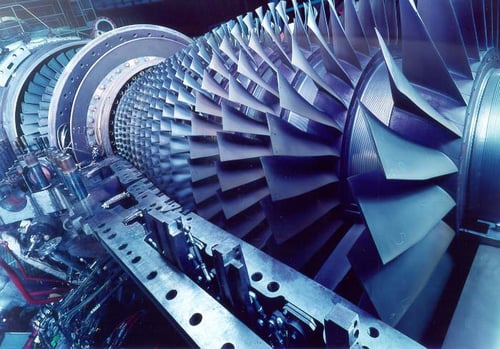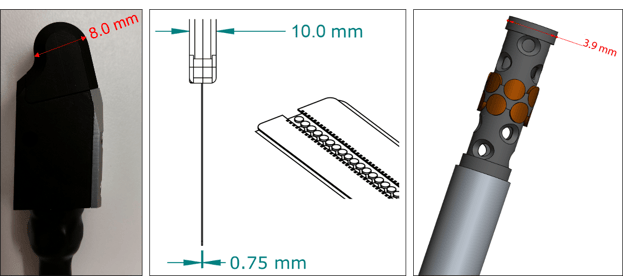The Basics: Disk Groove Inspection
The tremendous centrifugal loads acting on the blades of a gas turbine make the attachment point at their root prone to fatigue cracking which can drastically decrease the serviceable life of a turbine if left unchecked. This can become a concern for the blade roots themselves, but also for the joints on the disk to which they are attached. These joints often have complex dovetail-like geometries that are tedious to inspect with penetrant testing (PT) or conventional eddy current testing (ECT). Both techniques also rely on the skills and attentiveness of the inspector to ensure that no crack is left undetected.

In comparison, ECA probes can be embodied into a mechanism that has the exact profile and curves of the surface that needs to be inspected. Much ink has been spilled already on the topic of dovetail groove inspection with ECA instrumentation, undoubtedly because of how well it showcases the efficiency and consistency that ECA brings to the power generation industry. As an example, the probes shown below both contain an array of over 60 coil sensors enclosed in a rigid probe body with a dedicated surface profile, covering the full height of the dovetail grooves in one pass. These probes also feature a dual-wheel encoder that allows precise positioning of indications, including those located on the very edge of the part. The inspection manipulations could not have been made easier: all that remains for the operator is to push the probe along the length of the joint slot or blade root. Potential crack indications will be tagged automatically in the acquisition software, Magnifi®, based on an adjustable impedance threshold, making the probability of detection of cracks much more consistent and repeatable compared to visual inspection.

Beyond the Grooves: Advanced Turbine ECA Solutions
When it comes to fatigue stress in gas turbines, there is a lot more to discuss than just blade roots and dovetail grooves. Over the years, Eddyfi Technologies has developed custom ECA probes for a wide range of challenging applications:
-
Fully flexible probes for inspecting the surface of blades in one pass
-
Small array probes for inspecting the leading edge of blades
-
Spring-loaded scanner for bolt hole inspection
-
Extra-large rigid probe for inspecting the inner surface of bore holes
-
Custom ECA probes for inspecting the nut grooves
-
Needle-like probes for the inspection of cooling holes of all sizes
-
Thin blade-like probes with sub-millimeter thickness for the inspection of narrow gaps and interstices between disks and spacers
-
Captive probes for inspecting various slots of complex geometries

Additionally, the figure below shows a few prototype solutions for some of the most challenging surfaces to inspect in a gas turbine.

Left: Side view of a small rigid probe for the inspection of tight radius slots; Center: Side view of a blade probe as thin as a credit card for surface inspections through narrow gaps; Right: Needle-like probe with miniaturized eddy current sensor coils for the inspection of cooling holes.
The Importance of Quantitative Data for Turbine Inspection
Detecting and locating cracks in turbine components is only part of the work required to evaluate the operational safety and mechanical integrity of a turbine. Indeed, being able to evaluate the depth of the cracks brings invaluable additional information.
Any technician with experience in liquid PT inspection can confirm that the amount of penetrant that bleeds back onto the surface is often proportional to the depth of a crack. But they will also admit that the relation between the bleed-back and the depth of an indication is not well established and cannot be used as a reliable means for depth measurements of cracks in turbine components.
On the other hand, ECA provides a quantitative and repeatable impedance measurement that can be correlated with the length and depth of a crack. The use of ECA for the depth evaluation of cracks is specifically interesting for gas turbines due to the nature of the flaws (mostly sparse and shallow cracks) and components being inspected (high-quality alloys, clean surfaces without major corrosion, absence of coating).
The C-scan below, acquired with Magnifi, shows an example of results acquired on a dovetail calibration block that contains a series of EDM notches of various lengths and depths. As displayed in the impedance plane on the right, each of these artificial flaws is associated with a specific impedance amplitude:
 Using a set of indications of the same length, Magnifi can generate a sizing curve that can then be used to evaluate the depth of potential crack indications:
Using a set of indications of the same length, Magnifi can generate a sizing curve that can then be used to evaluate the depth of potential crack indications:

Because the amplitude of an indication is also affected by the length of a crack, Magnifi allow the use of multiple sizing curves in parallel.
Register for our expert-led webinar showcasing this application in real-time here.
Custom Capabilities for the Power Generation Industry
The takeaway here is that Eddyfi Technologies has developed a strong expertise in the inspection of gas turbines over the last decade with the development of dozens of customized ECA probes tailored to a wide variety of components. With its quantitative assisted analysis tools, Magnifi combines perfectly with these custom probes and the Ectane® 3 or Reddy® electronics to offer a complete and reliable inspection solution.
Our engineering experts are always eager for new challenging eddy current applications in the power generation industry. And when it comes to volumetric inspection, Eddyfi Technologies also offers leading-edge phased array technology (check out a blade root inspection example here). Whichever way you look, we have your advanced NDT needs covered. Contact us with your specific questions or requests today, and stay Beyond Current.
Looking for more? Check out our on-demand webinar featuring the inspection of turbine blade slots here.





